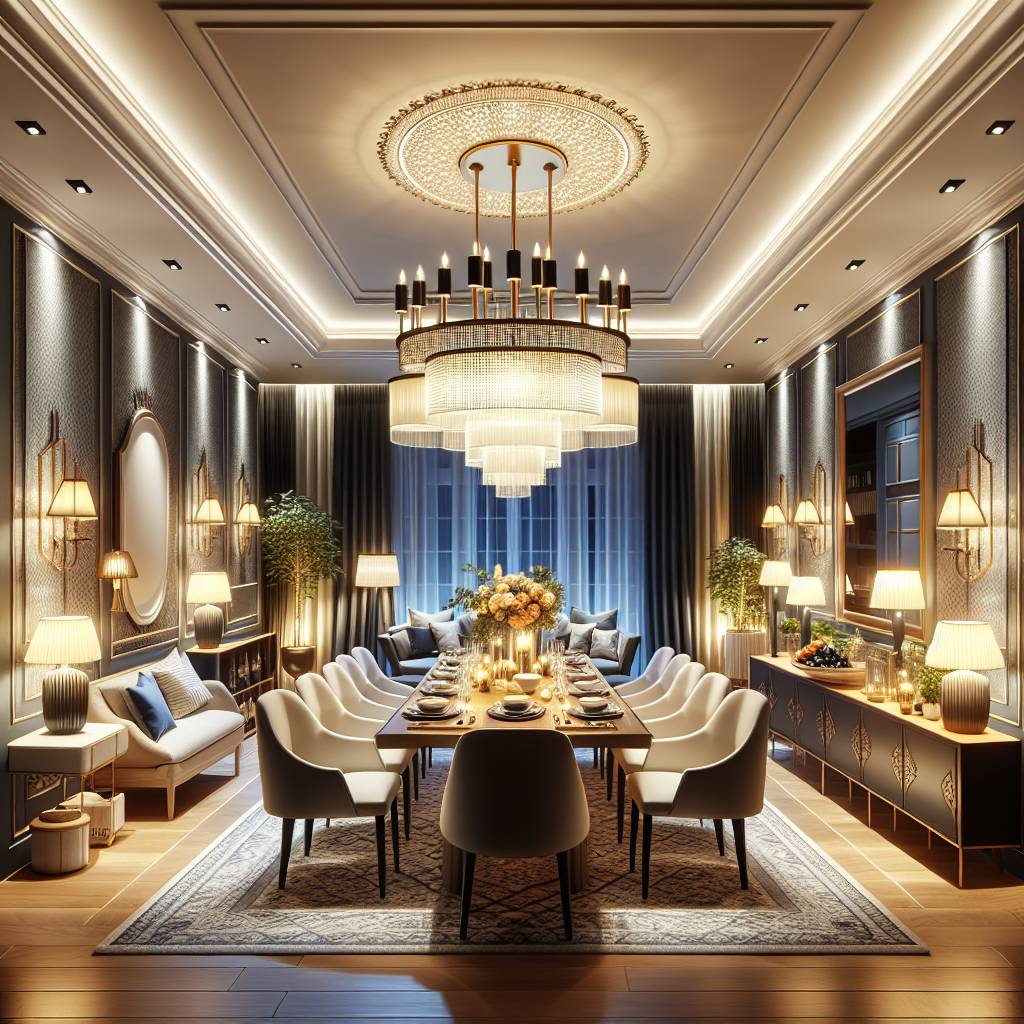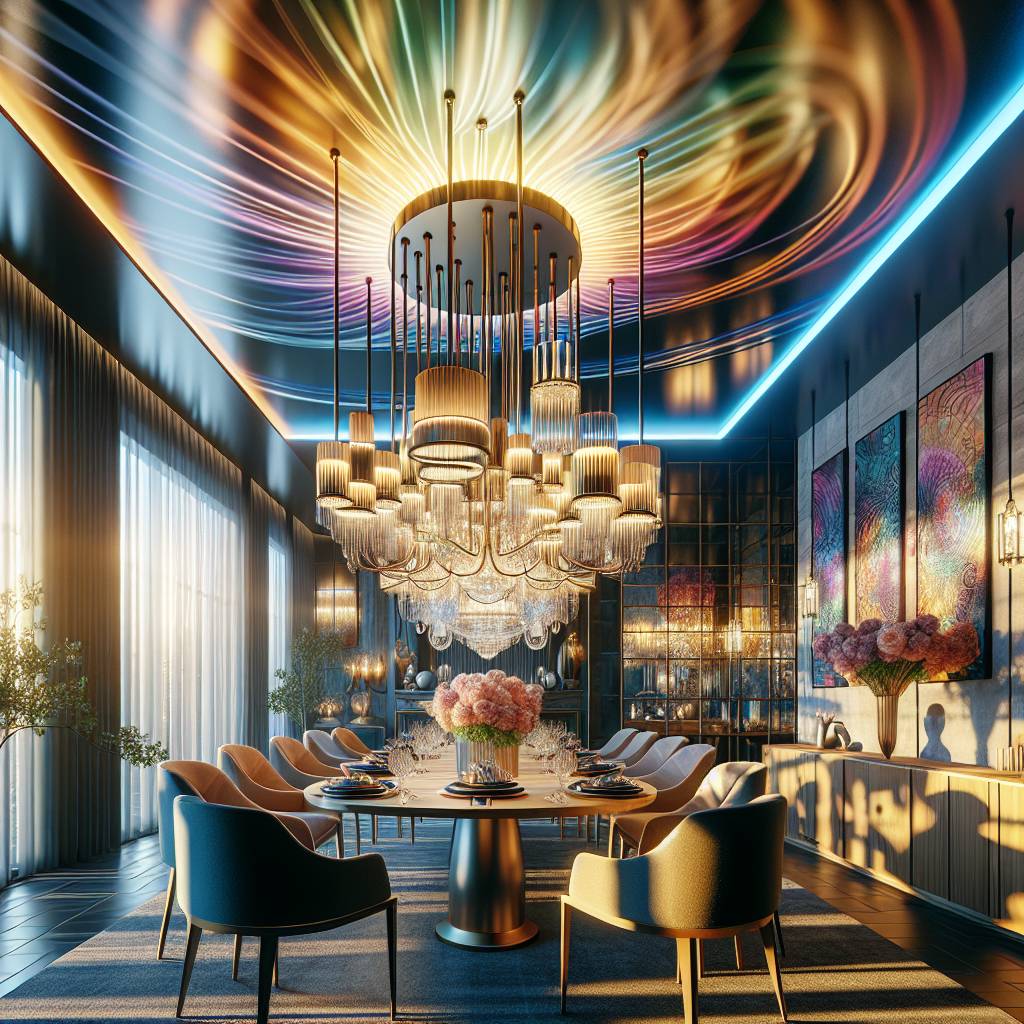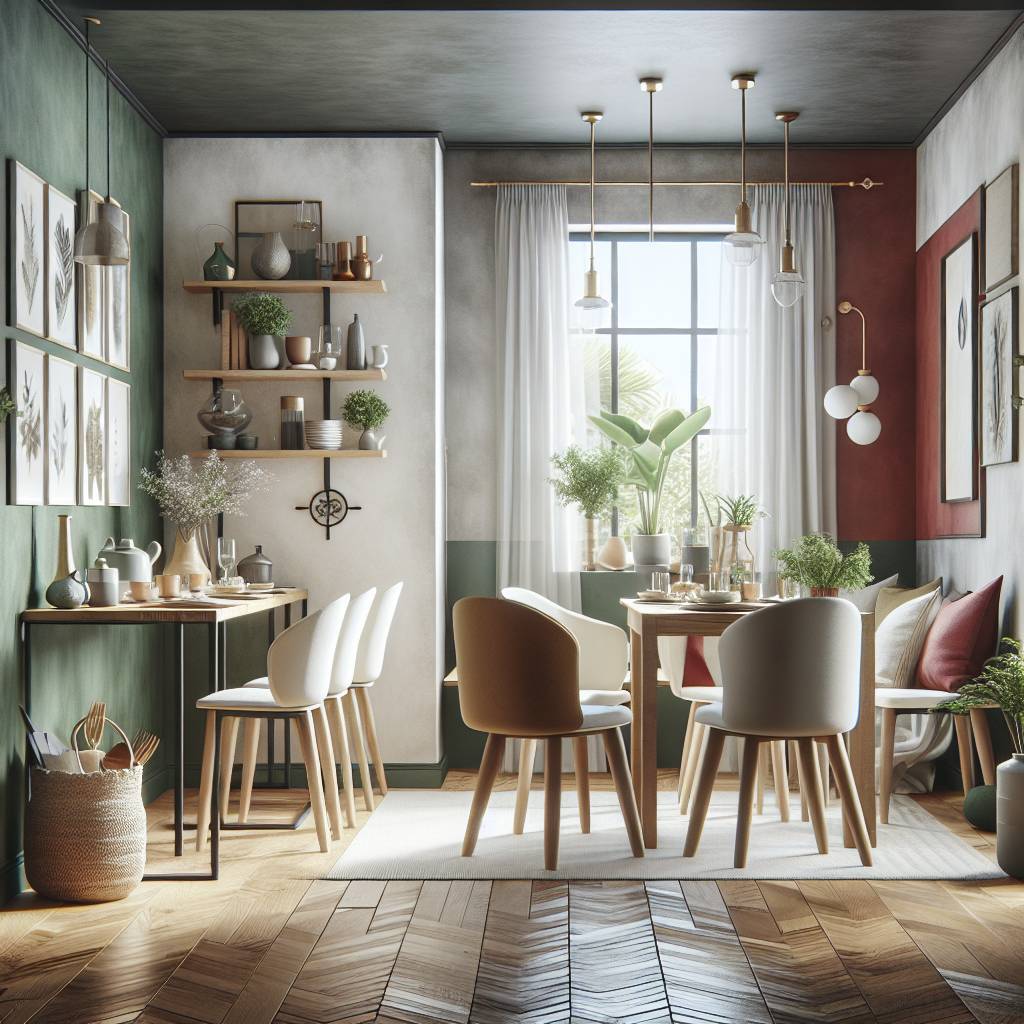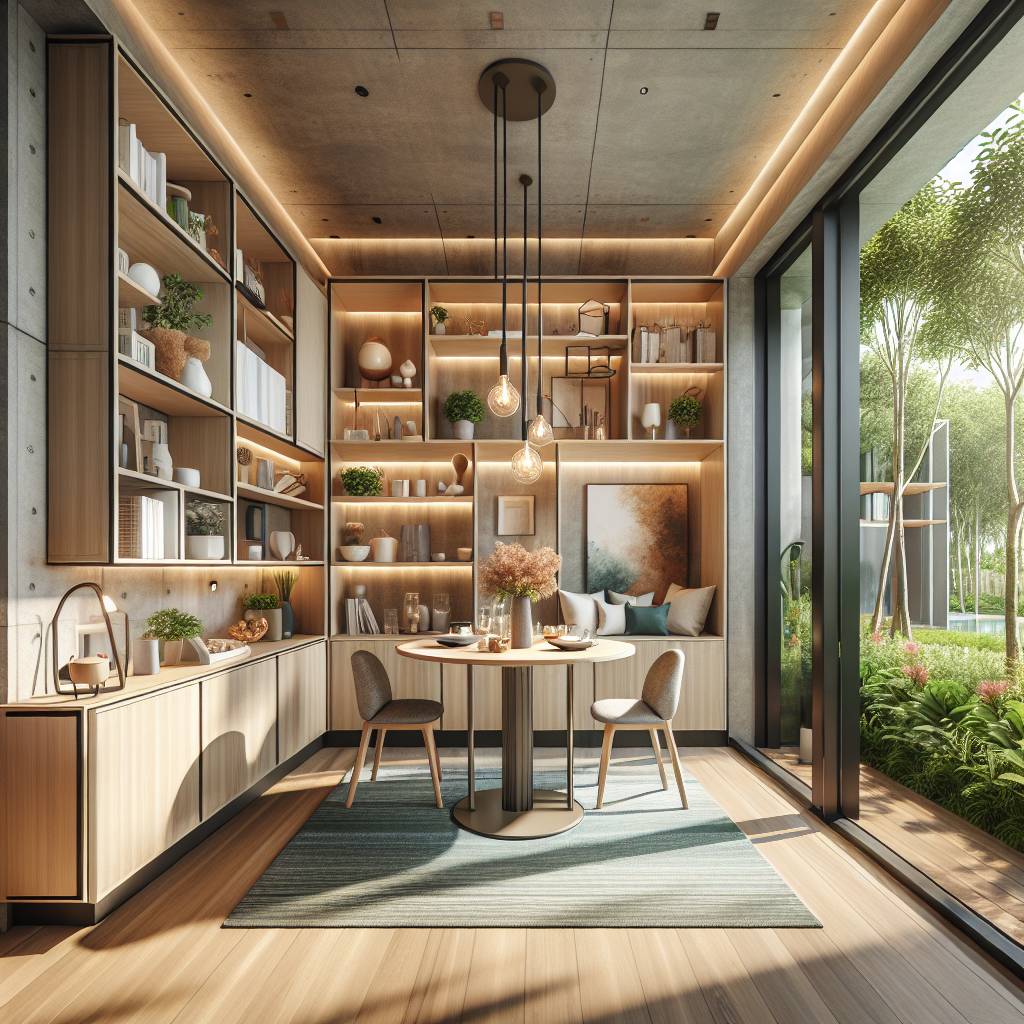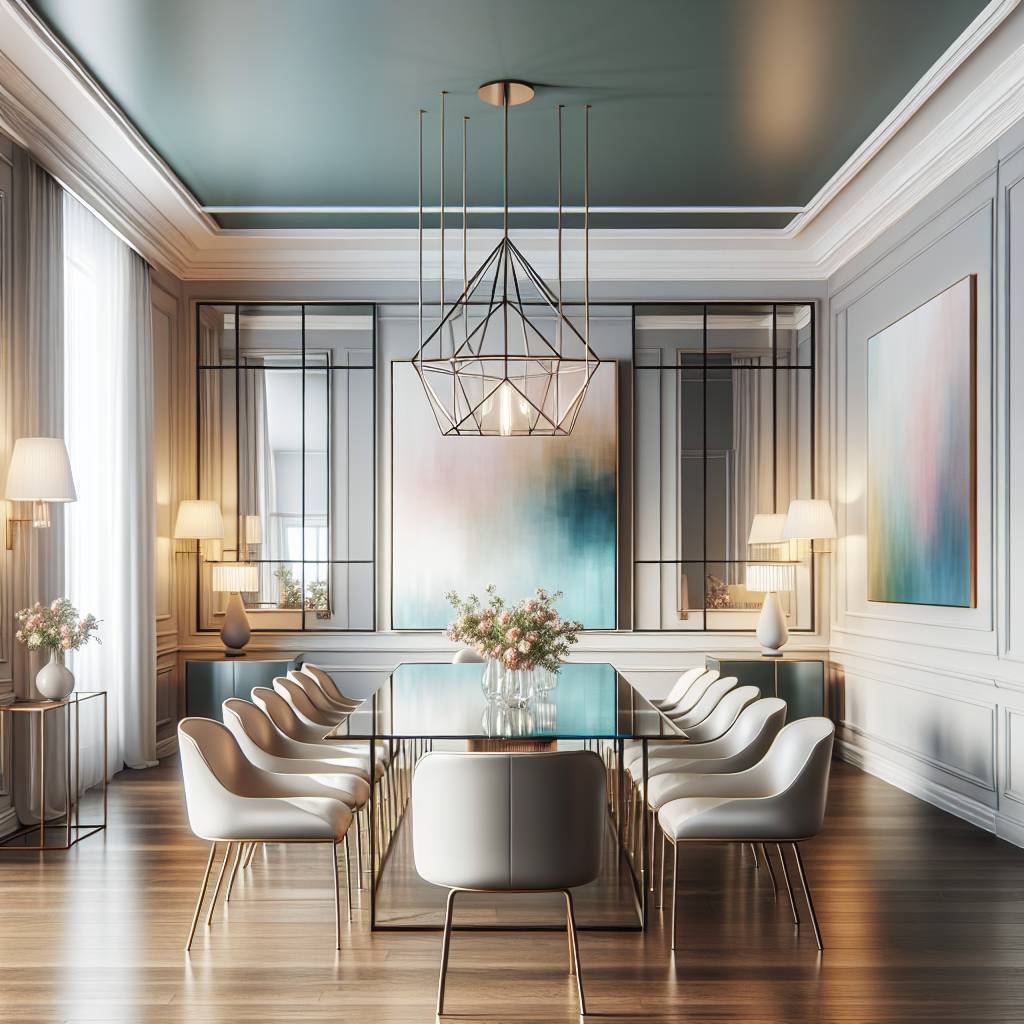Did you know that 85% of people feel that the general illumination in a dining room significantly impacts their dining experience? Lighting can make or break the ambiance, and mastering the art of layering light is crucial for creating an inviting space. In this guide, we’ll delve into the intricacies of layering light in your dining room to elevate both its functionality and aesthetics.
We’ll explore how to blend ambient, task, and accent lighting seamlessly to set the right mood for any occasion. From choosing the perfect chandelier or pendant lights, incorporating sconces and dimmers, to strategically adding recessed lighting for a well-lit dining room, we’ve got you covered. Whether it’s a cozy family dinner or a lively gathering with friends, understanding how to layer light effectively will transform your dining area into a captivating haven.
Key Takeaways
- Light Layering Benefits: Layering light in your dining room enhances ambiance and functionality, creating a warm and inviting atmosphere while allowing for different lighting options for various occasions.
- Consider Fixture Types: Understanding the different types of dining room lighting, such as ambient, task, and accent lighting, is crucial for effective light layering. Each type serves a specific purpose and contributes to the overall ambiance.
- Strategic Planning: Strategic planning is essential for successful light layering. Consider the room layout, desired atmosphere, specific lighting needs, and platform to create a cohesive and balanced lighting design.
- Fixture Selection Tips: When choosing fixtures for light layering, prioritize coherence with the room’s style, consider the scale of the fixtures, and ensure they complement each other to achieve a harmonious lighting scheme.
- Addressing Placement Challenges: Overcoming placement challenges, such as ceiling height variations or architectural obstacles, requires creative solutions to ensure that each layer of light is effectively distributed throughout the space.
- Control and Dimming: Implementing control and dimming options allows for flexibility in adjusting light levels, accommodating various activities and moods, and maximizing the impact of light layering in your dining room.
The Importance of Light Layering
Enhancing Ambiance
Light layering is crucial for creating a warm and welcoming ambiance in your dining room. By incorporating different lighting levels, you can enhance the overall mood, making the space more inviting for gatherings and meals. For example, using dimmer switches and light bulbs allows you to adjust the brightness according to the desired atmosphere.
Ambient lighting plays a significant role in setting the tone for the dining experience. It provides a soft, general glow that fills the room, creating an intimate and cozy environment. Imagine having dinner under gentle pendant lights or sconces that cast a warm glow over your dining table – it’s all about setting the right mood for enjoyable meals with family and friends.
Balancing Functionality
Achieving a balance between functionality and aesthetics is essential. Task lighting, such as under-cabinet lights or adjustable track lighting above the buffet, ensures practicality by providing focused illumination where needed. This type of lighting supports various activities in your dining room, from food preparation to reading recipes or doing homework at the table.
By integrating balanced lighting design, you cater to multiple needs within this space while also elevating its visual appeal. For instance, combining recessed ceiling lights with decorative chandeliers not only offers ample brightness but also adds an elegant touch to your dining area. This harmonious blend of functionality and style enhances both usability and aesthetics.
Design Aesthetics
Incorporating layered lighting contributes significantly to enhancing design aesthetics in your dining room. It adds depth and visual interest while complementing other elements of interior design such as furniture, wall colors, and decor accessories. For example, strategically placing accent lights above artwork or architectural features draws attention to these focal points while adding drama to the overall space.
Aesthetically pleasing fixtures play a key role in shaping the ambiance of your dining area too – whether it’s classic crystal chandeliers exuding timeless elegance or modern pendant lights showcasing sleek designs; they become integral parts of your interior scheme. These fixtures not only provide illumination but also serve as statement pieces that elevate the visual appeal of your dining room.
Types of Dining Room Lighting
Ambient Lighting
In a dining room, ambient lighting sets the overall mood. It’s like the canvas on which you paint different scenes. Soft ambient light creates a warm and inviting atmosphere, making it ideal for entertaining guests or enjoying family dinners. When evenly distributed, ambient light ensures that every corner of the dining area is well-lit.
To achieve this effect, consider using chandeliers or pendant lights with dimmer switches. These fixtures provide a gentle glow that fills the room without creating harsh shadows. By adjusting the brightness, you can tailor the level of illumination to suit various occasions – from intimate gatherings to lively dinner parties.
Task Lighting
Task lighting focuses on specific areas in your dining room where activities take place – primarily, the dining table itself. For example, adjustable table lamps can be positioned strategically to illuminate mealtime tasks while enhancing functionality during meals or other activities.
Proper task lighting is essential for reducing eye strain and improving visibility during tasks such as reading menus or writing notes at the table. This type of lighting also adds an intimate touch to individual seating areas by casting focused pools of light onto each seat.
Accent Lighting
. This type of lighting highlights artwork, decor pieces, or architectural features within your space. Well-placed accent lights draw attention to these elements and contribute significantly to creating a layered and dynamic environment in your dining area.
Consider using wall sconces or picture lights to showcase paintings or photographs displayed in your dining room. Alternatively, track lighting can be used to emphasize unique architectural details such as exposed beams or decorative molding along walls and ceilings.
Fundamentals of Light Layering
Light Placement
Strategic placement of lights in your dining room is crucial for creating a balanced illumination effect. By positioning lights thoughtfully, you can minimize glare and shadows, ensuring that every corner of the dining area is well-lit. This careful consideration enhances the overall dining experience, making it more inviting and comfortable for both everyday meals and special occasions.
For example, placing a pendant light directly above the dining table not only illuminates the area effectively but also adds a touch of elegance to the space. Similarly, wall sconces strategically positioned around the room can contribute to a warm and welcoming ambiance without overpowering the entire space with intense light.
Varying light intensities within your dining room allows you to add depth and dimension to the space. By adjusting intensity levels, you can create different atmospheres suitable for various occasions such as intimate dinners or lively gatherings. Lower intensity lighting may be ideal for creating an intimate setting during romantic dinners while higher intensity might be preferred when hosting larger groups or events.
Intensity Variations
Different activities in your dining room call for varying light intensities. For instance, softer lighting could be more suitable for relaxed family meals or evening conversations, while brighter lighting might be preferred when working on projects at the table or engaging in board games after dinner.
Moreover, carefully planned intensity variations cater to different preferences among family members or guests using the dining area. Some individuals may prefer softer ambient lighting during meals while others might appreciate brighter illumination when reading at the table.
Color Temperature
Selecting appropriate color temperatures significantly influences how people feel in your dining room. Warm color temperatures (such as soft white or warm white) create a cozy and intimate ambiance perfect for leisurely family dinners or romantic evenings with loved ones. On the other hand, cooler color temperatures (like bright white) promote alertness and focus during meals – ideal if your dining area doubles up as a workspace where tasks are completed over dinner.
Planning Your Layered Lighting
Assessing Space
Assessing the space is crucial. Understanding the size and layout of the dining room helps ensure proper coverage of light throughout the area. For instance, a larger dining room may require multiple light sources strategically placed to evenly illuminate the entire space.
The spatial dynamics play a significant role in determining suitable lighting options. By understanding how natural light enters the room and how furniture is arranged, you can identify areas that need more focused illumination. This assessment ensures that each corner of the dining room receives adequate lighting for various activities such as dining, reading, or entertaining guests.
Light Sources Coordination
Coordination of different lighting layers guarantees a harmonious blend of illumination in your dining room. Mixing various light sources such as ambient, task, and accent lights adds complexity and richness to your lighting design. For example, combining pendant lights over the table with wall sconces or floor lamps creates an inviting ambiance while providing practical illumination for specific tasks.
Proper coordination prevents conflicting or overwhelming lighting effects that could disrupt the overall atmosphere in your dining area. Each layer should complement one another rather than compete for attention. This synergy between different types of lighting enhances visual interest while serving functional purposes.
Control Systems
Implementing control systems offers personalized adjustments for your layered lighting elements in the dining room. Smart controls enable convenient management of layered lighting, allowing you to tailor brightness levels based on specific needs or preferences at different times throughout the day.
With control systems in place, flexibility becomes key when adapting to various scenarios within your dining space – from intimate dinners to lively gatherings with friends and family members.
Choosing the Right Fixtures
Style Compatibility
When layering light in your dining room, it’s crucial to ensure that the lighting fixtures align with the overall style and theme of the space. For instance, a modern chandelier might not complement a traditional or rustic-themed dining room. Properly chosen fixtures have the power to enhance the aesthetic appeal of the area, creating an inviting ambiance for meals and gatherings. By selecting styles that are compatible with the existing decor, you can achieve a cohesive look within your dining area.
Consider how different lighting styles can impact the atmosphere of your dining room. A sleek, contemporary fixture may bring a touch of sophistication to a modern setting, while an ornate chandelier could add elegance to a more classic space. The key is to choose lighting options that seamlessly blend in with your overall design scheme.
Scale and Proportion
Another essential aspect when layering light is ensuring that your fixtures are properly scaled in relation to the size of your dining room. Balanced proportions maintain visual harmony and prevent any single element from overpowering or underwhelming its surroundings. Large rooms may require bigger fixtures for adequate illumination without appearing disproportionate, while smaller spaces benefit from more delicately sized options.
Imagine walking into an oversized chandelier dominating a cozy nook—it would feel overwhelming and out of place compared to one appropriately proportioned for its environment! When considering scale and proportion for dining room lighting, think about how each fixture contributes not only functionally but also aesthetically.
Fixture Efficiency
In addition to aesthetics, evaluating fixture efficiency plays a significant role when choosing lighting elements for your dining area. Opting for energy-efficient fixtures isn’t just about reducing electricity consumption; it’s also about making sustainable choices that contribute to cost savings and environmental responsibility.
Energy-efficient LED bulbs provide ample illumination while consuming less power than traditional incandescent or fluorescent options—this means lower energy bills over time! Considering fixture efficiency ensures you’re making environmentally conscious decisions without compromising on brightness or style.
Overcoming Placement Challenges
Outlet Locations
Carefully planned outlet locations are essential for creating a well-layered lighting scheme in your dining room. When strategically positioned, outlets facilitate the seamless integration of various light sources, ensuring that each fixture has easy access to power. This is crucial for achieving an organized and functional lighting setup. For example, if you plan to have pendant lights above the dining table, ensuring there’s an outlet directly above or nearby can make installation much easier.
Properly positioned outlets also ensure convenient access for powering different fixtures without the need for unsightly extension cords running across the room. This contributes to a cleaner and more polished look in your dining space while eliminating potential tripping hazards.
Outlet locations play a crucial role in achieving an organized and functional lighting setup because they determine where you can place specific types of fixtures. For instance, if you want wall sconces on either side of a buffet or hutch, having outlets at those precise locations will allow for seamless installation without any visible wiring disrupting the aesthetic appeal.
Fixture Flexibility
Opting for versatile and adaptable options allows you to create dynamic illumination based on changing needs within your dining room. Flexible fixtures enable you to adjust the intensity and direction of light as desired, catering to various activities such as intimate dinners or lively gatherings with friends and family.
Multi-functional fixtures offer versatility by providing different lighting levels that suit diverse dining scenarios. For instance, adjustable track lighting can be directed towards artwork or decorative elements during daytime use but then repositioned to illuminate the entire table during evening meals.
Fixture flexibility contributes significantly to dynamic and customizable lighting solutions because it empowers homeowners with the ability to transform their dining space according to different occasions simply by adjusting their light fixtures rather than investing in multiple specialized ones.
Achieving the Perfect Glow
Selecting Bulbs
Selecting the right bulbs is crucial. Different bulb types offer varying levels of brightness, color, and longevity. For instance, LED bulbs are energy-efficient and long-lasting, while incandescent bulbs emit a warm and inviting glow. The proper selection of bulbs impacts both energy efficiency and the desired ambiance in your dining room.
Properly chosen bulbs are essential for achieving optimal layered lighting effects. By using a combination of different bulb types with varied brightness and color temperatures, you can create a dynamic atmosphere in your dining area. For example, pairing dimmable LED fixtures with warmer-toned incandescent bulbs can add depth and warmth to the space.
Dimming Options
Dimming capabilities provide control over light intensity for diverse settings within your dining room. This feature allows you to adjust the level of illumination based on different moods or occasions. Whether it’s an intimate dinner gathering or a lively family brunch, having dimming options enables you to cater to varying atmospheres without needing additional lighting sources.
Proper dimming functionality enhances flexibility in creating desired atmospheres within your dining area. With this feature, you can reduce glare during meal times by adjusting the light intensity according to natural daylight changes or specific activities taking place in the room.
In addition:
- LED bulbs offer excellent energy efficiency.
- Incandescent bulbs emit a warm glow suitable for cozy dinners.
- Combining different bulb types creates a visually appealing layered effect.
Controlling Light Layers
Switches and Dimmers
Properly placed switches and dimmers are essential for easily managing the various layers of light in your dining room. Imagine having a dimmer conveniently located near the entrance, allowing you to adjust the brightness as soon as you step into the room. This thoughtful placement ensures that users can access and control the lighting without any hassle.
Their correct installation is crucial for creating a user-friendly experience with layered lights. For instance, having separate dimmers for ambient lighting, task lighting, and accent lighting enables precise control over each layer based on your specific needs. This not only enhances convenience but also adds versatility to your dining room’s atmosphere.
Switches and dimmers play a pivotal role in managing different aspects of layered lighting. By adjusting these controls, you can effortlessly transition from bright overall illumination during meal preparation to softer ambient light during dinner gatherings. It’s all about tailoring the light levels to suit different activities or moods within your dining space.
Smart Lighting Integration
Integrating smart technology into your dining room’s lighting setup offers an array of advanced control features that elevate your experience with layered lights. With smart integration, scheduling when each layer turns on or off becomes effortless – picture setting up automatic adjustments throughout the day without lifting a finger.
The convenience doesn’t stop there; imagine being able to command your dining room lights using just your voice or through an app on your smartphone. Smart technology makes this possible by providing intuitive ways to manage multiple layers of light seamlessly from anywhere in or outside of your home.
Moreover, smart integration doesn’t just offer convenient control; it also introduces innovative solutions for optimizing how you interact with layered lighting in your dining room. From creating preset “lighting scenes” for different occasions like dinner parties or cozy family meals to integrating sensors that automatically adjust light levels based on natural daylight – there are endless possibilities for enhancing the ambiance through smart technology.
Guidelines for Effective Layering
Visual Balance
Achieving visual balance in your dining room involves harmonizing different layers of light within the space. Properly balanced layers create an inviting atmosphere while avoiding harsh contrasts. For instance, combining ambient lighting with accent lights can help achieve a balanced look, ensuring that no single source of light overpowers the others.
Creating visual balance is essential as it contributes to an enjoyable dining environment. Imagine sitting down for a meal in a room where one area is brightly lit, while another is dimly illuminated – it would feel uncomfortable and disjointed. Therefore, by carefully considering and balancing the various lighting elements in your dining room, you can create a cohesive and pleasant ambiance for meals and gatherings.
Transition Zones play a crucial role in layering light effectively within your dining space. By creating transition zones between different layers of light, you ensure smooth blending of light effects across the entire area. Thoughtful transitions prevent abrupt changes in illumination levels across the dining space.
Carefully designed transition zones contribute to a cohesive and immersive lighting experience throughout your dining room. For example, when transitioning from general ambient lighting to task-oriented lighting above the table or counter areas, consider using wall sconces or soft uplights near seating areas to gently bridge these two distinct layers without causing discomfort or distraction.
Focal Points
Highlighting focal points with appropriate illumination draws attention to key features in the dining room, adding depth and character to specific areas. When layering light effectively, consider using focused spotlighting or pendant lights above art pieces on walls or decorative displays such as china cabinets.
Layered lighting emphasizes focal points by providing different levels of brightness around them—this adds depth and visual interest to those specific areas within the dining space. For instance, if you have an elegant chandelier hanging over your table as a central feature, complement its grandeur by incorporating softer ambient lighting around it through strategically placed floor lamps or recessed ceiling lights.
Focal point illumination plays an integral role in creating visually engaging focal areas within your dining space. By highlighting architectural details like molding or alcoves with well-placed accent lights or wall washers alongside other layered sources of light throughout the room will enhance its overall aesthetic appeal.
Final Remarks
Congratulations! You’ve now mastered the art of light layering in your dining room. By understanding the significance of different lighting types, mastering the fundamentals, and overcoming placement challenges, you’re well on your way to achieving the perfect ambiance for your dining space. Remember, effective layering isn’t just about functionality; it’s about creating an atmosphere that complements your gatherings and elevates your dining experience.
Now it’s time to put your newfound knowledge into action. Take a critical look at your dining room’s current lighting setup and start planning how you can incorporate various layers to enhance the overall feel. Experiment with different fixtures, play with light controls, and don’t be afraid to think outside the box. Your dining room is more than just a place for meals – it’s a space for connection and celebration, and now, it can shine in all its illuminated glory.
Frequently Asked Questions
FAQ
What is light layering and why is it important for a dining room?
Light layering involves combining different types of lighting to create a balanced, inviting atmosphere. In a dining room, it’s crucial because it sets the mood for meals, enhances the decor, and ensures functionality for various activities.
How can I overcome placement challenges when implementing layered lighting in my dining room?
To overcome placement challenges, consider using adjustable fixtures, such as track lighting or pendant lights with adjustable heights. Utilizing wall sconces or floor lamps can help fill in any gaps where traditional ceiling-mounted fixtures may not be suitable.
What are some effective guidelines for effectively layering light in a dining room?
Effective guidelines include incorporating ambient (general), task (focused), and accent (decorative) lighting to cover all aspects of illumination. It’s also essential to pay attention to fixture sizes and placements to ensure an even distribution of light throughout the space.
How do I choose the right fixtures for layered lighting in my dining room?
When choosing fixtures, consider the size and shape of your dining area. For example, linear chandeliers work well over rectangular tables while round chandeliers complement circular or square tables. Mix different types of fixtures like recessed lights with pendants for versatility.
What are some tips for achieving the perfect glow through layered lighting?
To achieve the perfect glow, use dimmers to adjust brightness levels according to different occasions. Incorporating warmer bulbs can create a cozy ambiance while cooler bulbs are ideal for tasks like reading or studying at the table.
